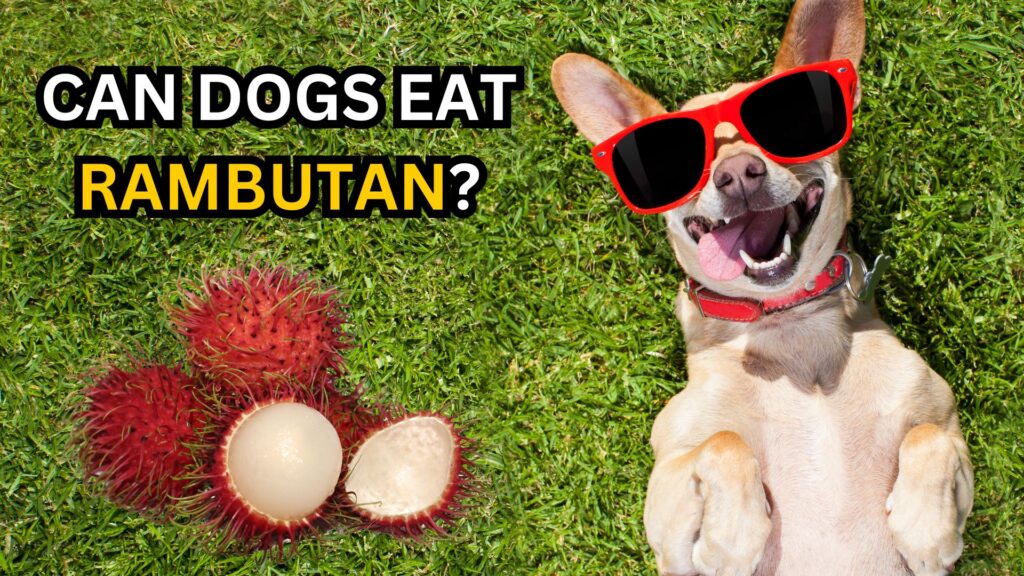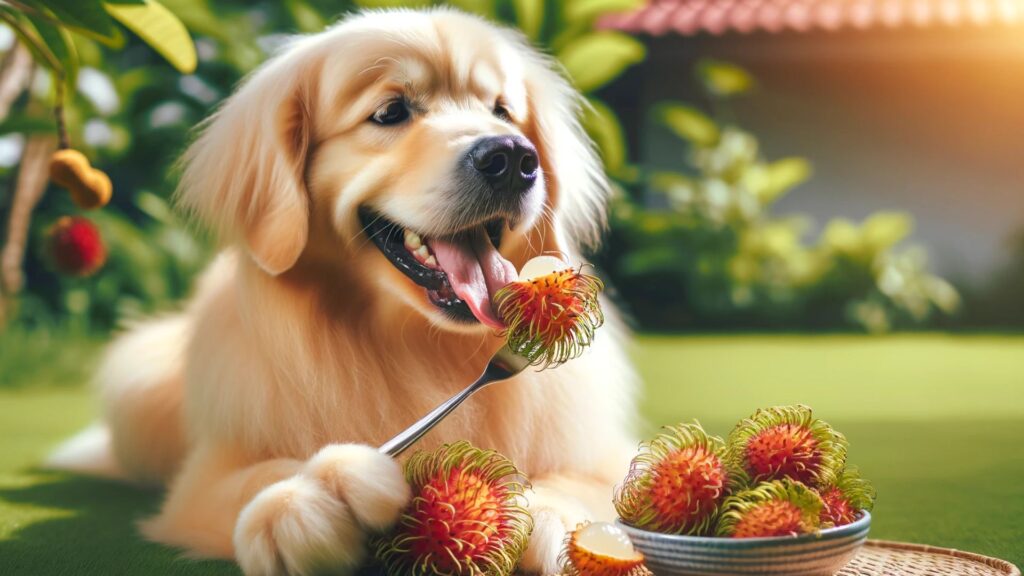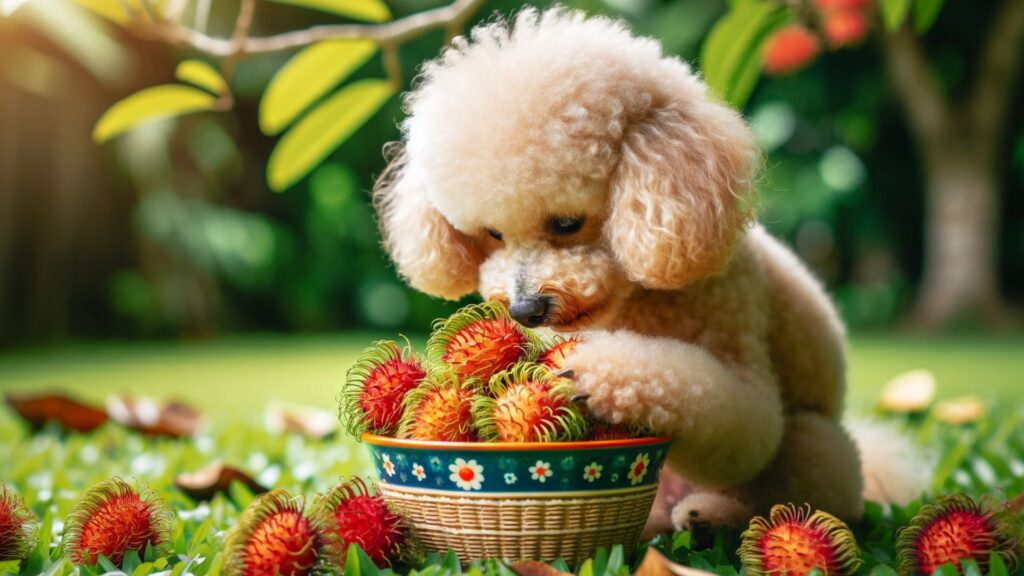Rambutan, a vibrant and exotic fruit, often catches the eye with its hairy exterior and sweet, juicy flavor. Originating from Southeast Asia, it has become a popular treat across the globe, tempting not only humans but sparking curiosity among pet owners too.
As we increasingly embrace diverse fruits in our diets, many dog owners wonder: can our furry friends enjoy these tropical delights as well?
This blog post delves into whether it’s safe for dogs to eat rambutan, addressing both the potential health benefits and risks involved.

What Is Rambutan?
Rambutan is a tropical fruit related to lychee and longan, all members of the soapberry family. The name “rambutan” is derived from the Malay word “rambut,” meaning hair, which describes the fruit’s unique, spiky appearance.
Typically red or yellow, rambutan encases a translucent, fleshy fruit inside its hairy shell, which is both sweet and creamy, often compared to grapes in texture.
Originating in the rainforest regions of Malaysia, Indonesia, and other parts of Southeast Asia, rambutan trees thrive in humid, tropical climates. As a seasonal fruit, rambutan is usually harvested twice a year, making it a periodic treat in native regions and an imported luxury elsewhere.
Nutritionally, rambutan offers a good source of vitamin C, manganese, and smaller amounts of potassium, iron, and fiber.
These nutrients contribute to its health benefits for humans, which include boosting the immune system, improving digestive health, and potentially fighting against free radicals due to its antioxidant properties.
Can Dogs Eat Rambutan?

When it comes to sharing rambutan with dogs, the main concern lies in the preparation. The flesh of the rambutan is safe for dogs to eat in moderation but requires careful handling. The outer skin and the seed inside are where the potential hazards lie.
The skin is tough and indigestible and can cause gastrointestinal upset or blockage, while the seed contains certain compounds that can be toxic if ingested.
Therefore, when offering rambutan to your dog, it is crucial to peel the fruit thoroughly and remove the seed. The edible flesh should be given in small quantities as a treat, not as a regular part of their diet.
This is especially important considering the natural sugars present in rambutan, which, when eaten in excess, can lead to health issues like obesity or diabetes in dogs.
In summary, while the juicy flesh of rambutan can be a safe and tasty treat for dogs, it requires careful preparation to avoid any risks.
Always ensure that the fruit is properly peeled and the seed removed, and monitor your dog’s reaction to this new addition to their diet, particularly if they have sensitive stomachs or other health concerns.
Pros of Feeding Rambutan to Dogs

Feeding rambutan to your dog can have several benefits if done correctly and in moderation.
Here are some of the positive aspects of including this exotic fruit in your pet’s diet:
Potential Health Benefits:
- Vitamins and Minerals: Rambutan is rich in vitamin C, which can help bolster the immune system of dogs, much like it does in humans. It also contains trace amounts of iron, magnesium, and potassium, which are essential for maintaining healthy bodily functions in pets.
- Antioxidant Properties: The antioxidants in rambutan, such as vitamin C, can help combat free radicals in dogs. This is beneficial for aging dogs, as antioxidants can help reduce inflammation and promote healthier skin and coat.
Suitable Serving Sizes and Preparation:
- Serving Sizes: As with any treat, rambutan should be given to dogs in moderation. A couple of pieces of the flesh (depending on the size of the dog) are adequate to reap the benefits without overindulgence.
- Preparation Tips: Always peel the fruit thoroughly and remove the seed before offering it to your dog. The flesh should be fresh and not from canned sources that may contain added sugars or preservatives.
Cons of Feeding Rambutan to Dogs
While there are benefits to feeding rambutan to dogs, there are also significant risks that need to be considered to ensure the safety and health of your pet:

Potential Risks and Side Effects:
- Hazards of the Seed and Peel: The seed of the rambutan is potentially toxic to dogs if ingested, as it can cause digestive blockages or even poisoning. The peel, although not toxic, is tough and fibrous and can lead to choking or gastrointestinal blockage if consumed.
- Possible Allergic Reactions or Gastrointestinal Upset: Like any new food, rambutan can cause allergic reactions in some dogs. Symptoms may include itching, hives, or gastrointestinal upset such as diarrhea or vomiting. If any of these symptoms occur, discontinue feeding rambutan and consult your veterinarian.
- Sugar Content Concerns: Rambutan contains natural sugars, which, when consumed in excess, can lead to weight gain or health issues like diabetes, particularly in dogs that are less active or already overweight.
While rambutan can be a tasty and healthy treat for dogs when prepared correctly, it is crucial to be aware of the potential risks.
Always start with a small amount to see how your dog reacts to this new fruit and consult your veterinarian if you have any concerns about introducing new foods into your dog’s diet.
This careful approach will help you avoid any negative side effects while allowing your dog to enjoy a new and exotic treat.
How to Safely Introduce Rambutan into Your Dog’s Diet

Introducing new foods into your dog’s diet should always be done with caution to ensure their safety and to gauge their tolerance. Here’s how to properly introduce rambutan to your dog:
Steps to Introduce Rambutan to Your Dog:
- Start Small: Begin by offering a small piece of the rambutan flesh (ensure it’s peeled and seedless) to your dog. Watch for any immediate reactions or dislikes.
- Monitor Closely: Over the next 24 hours, keep an eye on your dog for any signs of discomfort or adverse reactions.
- Gradually Increase: If your dog tolerates the rambutan without any negative side effects, you can slowly increase the amount over several days, still ensuring it remains a small portion of their overall diet.
Signs to Watch for Indicating a Bad Reaction:
- Digestive Issues: Look out for symptoms like diarrhea, vomiting, or excessive gas.
- Allergic Reactions: Symptoms could include hives, swelling, or difficulty breathing. Any of these signs should prompt an immediate call to your veterinarian.
- Behavioral Changes: Unusual lethargy, discomfort, or agitation following consumption may also indicate a problem.
Recommended Frequency and Quantity:
- Frequency: Rambutan should be considered an occasional treat, not a regular part of your dog’s diet.
- Quantity: Depending on the size of your dog, a few pieces of the flesh once a week is sufficient.
Alternatives to Rambutan for Dogs

While rambutan can be a safe snack when prepared properly, there are other fruits that are easier to prepare and may already be known to be safe for dogs.
Here are some alternatives:
Safe and Healthy Fruits for Dogs:
- Apples (without seeds or core): Apples are high in fiber and low in fat, making them a great snack for dogs. They help to clean residue off a dog’s teeth, which helps to freshen breath.
- Blueberries: Known for their antioxidant properties, blueberries are a superfood that is great for dogs as well as humans. They are also low in calories and sugar.
- Bananas: In moderation, bananas can be a great low-calorie treat for dogs. They are high in potassium, vitamins, biotin, fiber, and copper.
- Watermelon (without seeds or rind): This fruit is a hydrating snack on hot days, being mostly water. It’s also packed with vitamins A, C, and B-6.
- Pears (without the core or seeds): Pears are a great source of vitamin C, vitamin K, and fiber. It’s important that the seeds and core are removed to prevent choking.
Each of these fruits can be included in your dog’s diet, but always in moderation to avoid excess sugar and calories.
Always remove seeds, pits, and inedible skins to prevent health issues. As with any dietary addition, observing how your dog reacts to small amounts first is crucial. This not only ensures they like what they’re eating but also that they’re not adversely affected by it.
FAQs
How often can my dog eat rambutan?
Rambutan should be given as a treat, not as a regular part of your dog’s diet. It is advisable to limit rambutan consumption to a few pieces once or twice a week at most. Always monitor your dog’s reaction to the fruit each time.
What should I do if my dog reacts badly to rambutan?
If your dog shows signs of an allergic reaction or gastrointestinal upset after eating rambutan, such as vomiting, diarrhea, hives, or difficulty breathing, remove any remaining fruit and discontinue feeding it. Consult your veterinarian immediately for advice and possible treatment.
Are there other exotic fruits safe for dogs?
Yes, other exotic fruits like mango, papaya, and dragon fruit can be safe for dogs if prepared properly (i.e., peeled and deseeded). However, introduce these fruits into your dog’s diet gradually and in moderation, observing how your dog responds to each.
How do I remove the seed safely from rambutan for my dog?
To safely remove the seed from rambutan, peel off the hairy outer layer first, then split the fleshy part carefully with a knife to expose the seed. Remove the seed completely before offering the fruit to your dog to prevent any risk of choking or toxicity.
Can rambutan seeds be toxic to dogs?
Yes, rambutan seeds are considered potentially toxic to dogs. They contain certain chemicals that can be harmful if ingested. Always ensure to remove the seeds completely before giving rambutan flesh to your dog.

Conclusion
In this blog post, we’ve explored the intriguing question of whether dogs can eat rambutan and discussed the safe ways to introduce this exotic fruit into their diet. While rambutan can offer some nutritional benefits to dogs, like vitamins and antioxidants, it also presents risks, primarily due to its seed and peel which can be harmful if ingested.
Key takeaways include:
- Serve rambutan flesh in moderation, ensuring it’s peeled and seedless.
- Watch for any signs of allergies or digestive issues.
- Consider other dog-safe exotic fruits as alternatives.



0 Comments